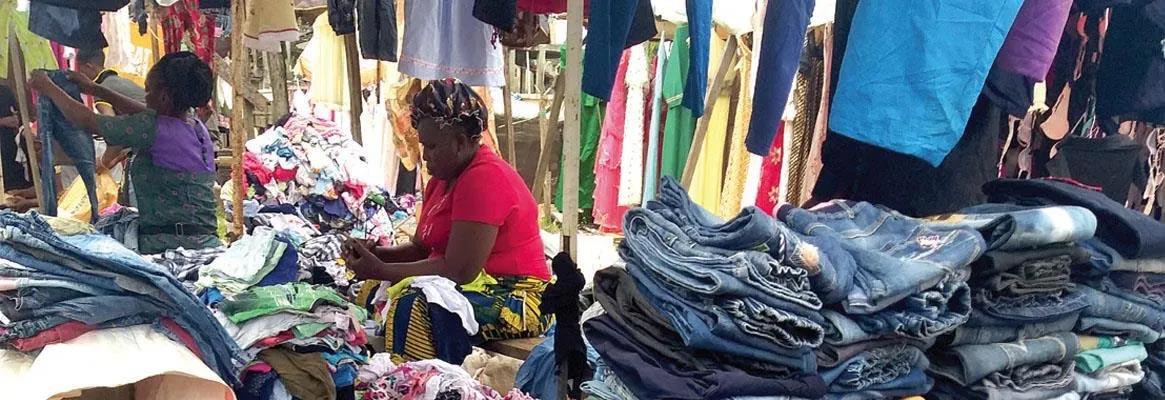Africans don’t want second-hand clothing… but it is often the quality many can afford.
From Kimironko market in Kigali to Gikomba market in Nairobi, Aswani market in Lagos, and Kariakoo market in Dar es Salaam, tonnes of second-hand clothing from North America and Europe are displayed in small stalls and sidewalks, with thousands of patrons sifting through bales of clothes donated to charity by their original owners. Going for as low as $1 each, these clothes are popular in Africa, where 85 per cent live on less than $6 a day. Their popularity comes at the detriment of the local fashion industry, which continues to struggle in the face of cheaper alternatives.
The import of used clothes from the West began through the International Monetary Fund’s structural adjustment programmes in the 1980s, which forced privatisation and substitution with imports from developed countries. This is according to a report by investment advisory and strategy consulting firm Botho Emerging Markets Group. The firm noted that this decimated many of Africa’s once-thriving textile and apparel industries.
Although the removal of barriers to trade made import and export easier, it also “made African economies more vulnerable to import”. Andrew Brooks noted this in his book Clothing Poverty: The Hidden World of Fast Fashion and Second-hand Clothes. According to him, “manufacturing industries, in particular, became uncompetitive.” To put this into perspective, Ghana suffered a decline in textile output of about 50 per cent between 1975 and 2000. From 125 in the early 1990s, the number of Nigerian textile factories fell to less than 40 in 2010. By 2002, employment in the Zambian textile sector had dropped to below 10,000 from 25,000 in the 1980s. Today, Kenya’s garment industry employs only 50,000 people—a drastic drop from about 500,000 in the 1980s.
Some countries in Africa introduced policies to discourage or outrightly stop the import of second-hand clothing as a result. They had hoped this would revive their local textile industries and foster economic growth. For example, Rwanda raised tariffs on imports of used apparel and footwear by more than 1,000 per cent, effectively banning imports of these products. The United States reacted by suspending the country’s African Growth and Opportunity Act (AGOA) benefits for a class of imports that totalled $1.5 million in 2017. AGOA promotes trade by providing reduced or duty-free access to the US market. But to Rwanda, the long-term benefits of its action far outweigh the short-term benefits of AGOA. Rwanda’s move came after a plan hatched at the 16th East African Community (EAC) heads of states summit. At the summit, members agreed to gradually end the import of used clothing to develop their local textiles and apparel industries. However, no other EAC country joined Rwanda in seeing the plan through after the US issued its threats.

Although only 3 per cent of Rwanda’s exports to the US is affected by the enforcement of AGOA requirements, a lot of people think it was a bad idea. One of them was Johannes Otieno, who was the manager at Utexrwa, which makes uniforms for the army, the police, and hospitals in Rwanda.
“Do we have a ready market here to which we can feed ‘Made in Rwanda’ clothes to the population?” he asked the New York Times in 2017. “We depend on America for a lot of things. We’re not stable enough to say, ‘We don’t need you anymore.’”
However, Rwanda has survived America’s action, with a goods trade surplus of $42 million in 2018. So, Kenya was encouraged to try again. The East African country introduced a ban on second-hand clothing, leveraging the perceived threat to people’s health during the covid-19 pandemic. Phyllis Wakiaga, chief executive of the Kenya Association of Manufacturers, and Wagura Kamwana, proprietor of a fabric shop, the Textile Loft, both saw the ban as a big opportunity to produce clothes locally for Kenyans. However, several others, including the Mitumba Association of Kenya, wanted the ban lifted. The Kenyan government has now obliged.
Granted, it provides the opportunity to get quality designer clothing at low prices. People in favour of continued imports of second-hand clothing in countries like Kenya also claim a ban will lead to the loss of millions of jobs. This was also the argument put forward by the Secondary Materials and Recycled Textiles Association (SMART) of the US in its petition to the US government in 2017. The organisation prayed that the US government took action as the planned ban on second-hand clothes by EAC states would lead to loss of jobs in the African region. But more important was the estimated 40,000 US jobs that could be lost if the EAC saw its plan through.
“Evidently, American jobs are untouchable and are protected at all costs by American policymakers. Our policymakers should follow suit in creating and protecting Kenyan jobs at all costs,” Isaac Kalua, founder of Kenya-based Green Africa Foundation wrote in The Standard. While he understands the concern over the potential loss of jobs, Kalua argues that the country had more to gain in the long-term if it upheld the ban on second-hand clothing, but it didn’t.
If Africa would protect jobs as aggressively as SMART did, countries on the continent need to play the long game like Rwanda. Its policy may not work for every African state, but they need to take a cue from how it is foregoing immediate positive economic impact for more robust growth in the long term. A good way to start is addressing the real challenges affecting local manufacturing, such as weak business environment, high cost of production, and low-level infrastructure, among others.
As Kalua notes, Kenya, and indeed, Africa’s “global competitiveness is anchored on our capacity to reinvent and strengthen our local industry.” The textiles and apparel industry presents a unique opportunity for Africa, with the industry expected to double in the next 10 years, generating up to $5 trillion annually.
The African Development Bank sees this opportunity and is working to ensure the continent benefits. The bank has launched the Fashionomics Africa initiative to support the development of small and medium-scale enterprises in the African textiles and clothing industry. The lender provides access to finance and access to markets through ecommerce. Efforts like this are certain to deliver more impact than any ban on second-hand clothing would achieve.
As Ehis Okpamen, a Lagos-based economist, submits, “We all want to see Africa grow and the economic status of its people improve. When traders in second-hand clothing start selling new clothes and people who could only afford used clothes start buying new ones, that is growth”.
“There are deeper issues Africa needs to fix. You can’t ban your way into development,” says Okpamen, who is clearly against banning second-hand clothing. Instead, he prefers that African leaders fixed their socio-economic issues. “There’s a reason people settled for used clothing in the first place.”
This article was first published in the November 2020 edition of the print magazine.











Comments